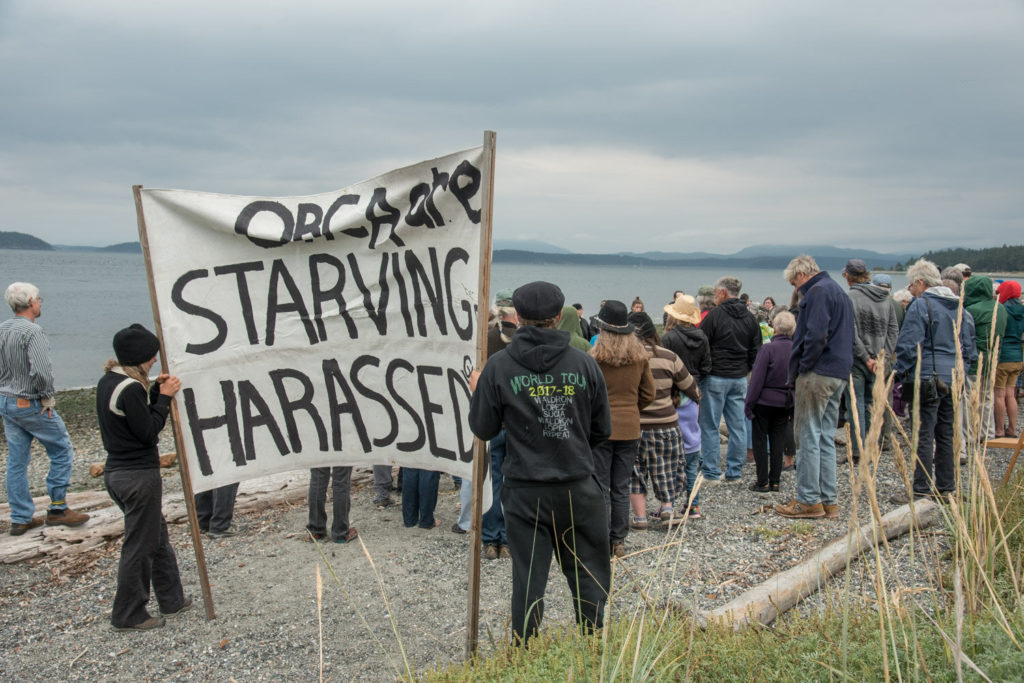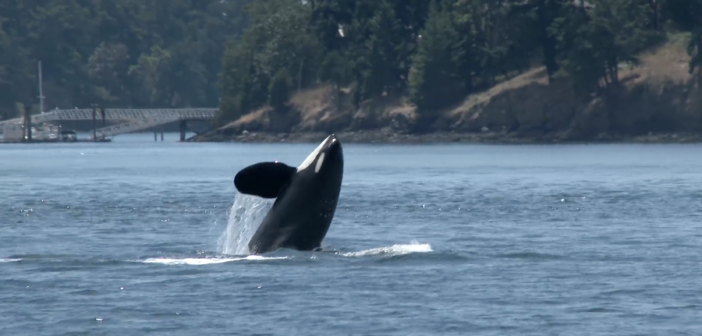The Southern Resident Killer Whales (SRKW) are a group of orcas, made up of three pods, who live off the Pacific coast of the United States and Canada. In the Pacific Northwest, they are well known for being beloved and iconic to the region. Unfortunately, they are also known for being highly endangered, with their dwindling population now at a 30-year low of only 73 individuals.
Depleted salmon populations and pollution get plenty of recognition as threats to the SRKWs. What isn’t as widely known, despite plenty of evidence, is the threat posed to these whales by boat noise, especially the noise caused by commercial whale watching. It may come as a surprise that this activity, which might seem like a harmless way to appreciate wildlife, is playing a big part in making it harder for the SRKWs to eat, communicate, and survive.
In the new short documentary Sentinels of Silence?, filmmaker Mark Pedelty explores the controversy around whale watching and the SRKW. In an interview with Pedelty, we discussed why this is such an important issue, why the whale watching industry persists in this region despite experts’ calls for a moratorium, and how people can appreciate wild orcas without harming them.
Dylan Forest: What drew you to make a film about noise pollution and the SRKWs?

Mark Pedelty: It was a mix of experience and research. Reading the bioacoustics literature and knowing how boat and ship engine noise masks orca communication, and then watching the way that they are followed incessantly whenever in the Salish Sea, motivated me to learn more and follow this story. In the past few years I have witnessed some truly grievous violations of distance limits and engine noise regulations, each time in cases when the over-stretched fish and wildlife boats could not make it out to police the whale watchers’ and recreational boaters’ behavior.
People may not immediately understand why noise pollution is such a concern for orca survival, and not just an annoyance. What about orcas makes excess noise so dangerous to them?
That’s one for which I will say, “Watch the film and find out.” ☺ Anthropogenic sound is overpowering for many animals that rely on sound to communicate. The orca coordinate their hunts, socialize, enculturate their young, and live as a unit via sound. Disrupting that is having grave consequences, especially in combination with the continued decline of Chinook salmon and the increasing toxin load as the Salish Sea becomes a densely populated, urbanized region.
What is so important about the SRKW’s in particular, and why are they in such desperate need of protection?
I always marvel at the thousands of orca images all over Washington state and Vancouver, BC. Clearly this is an iconic species that people identify with, use to market the region and individual businesses, and so on, yet when one realizes that there are only 73 SRKWs alive, the disconnect between idea and action is evident.
This is a very local issue, affecting a particular group of orcas in a specific region. Why should viewers in other places care about this issue too?
For Minnesota it might be the wolf (although it is hard to imagine anyone defending encircling and following wolves all day). For Alaska the polar bear. For the Sundarbans mangrove of India and Bangladesh, the tiger. Stewarding habitat for the top predator in each of these ecosystems matters greatly, ecologically speaking, and in terms of environmental justice. The First Nations of the Salish Sea teach us that the SRKWs are our relatives, and so what we do to the orca we do to ourselves. And all for a bit more convenience, unlimited access to everything, and ultimately a tragedy of the commons where that which brought us all here in the first place is destroyed and no longer a part of the world our great grandchildren will know.

In the film, the point is made that of the three main threats to the SRKWs (dwindling salmon populations, toxins, and noise pollution from boats), noise is the one we have the most ability to change. Why do you think this problem has gone on largely unaddressed, despite plenty of evidence that excess noise harms orcas and recommendations from experts to place a moratorium on whale watching?
In a word, or two: political economy. The industries most directly involved, from recreational boating and shipping, to tourism and whale watching, see any restriction on their movement as a potential threat to their bottom lines and livelihoods. Again, I wish we could think more in terms of intergenerational equity and realize how much better the future would be if we moderated some of our behavior and created refuges for the orca and salmon.
You present both sides of this argument: that of the whale watching industry, and that of the people fighting to create more protections from whale watching for orcas. Was your intention to present a particular side as right? Do you hope viewers come to a particular conclusion about this controversy?
The U.S. President of the Pacific Whale Watch Association, Jeff Friedman, was a delight to meet, and he does such an excellent job of representing the industry’s interests, as do the Balcombs, for example. That perspective needs to be heard, contextualized, and part of the policy debate. Unfortunately, this is among the many issues where money has spoken louder than science—and I speak here of a more complete and nuanced, scientific understanding of cetacean ecology—and that money has also been silencing. After reading the bioacoustics literature and meeting these amazingly brave advocates for considering all factors in whale conservation, I thought that their stories needed to be told as well.
Many people would think of whale-watching as an activity that is grounded in appreciation for whales. What are some alternatives to motorized whale watching that allow people to appreciate whales without harming them?
Reading about them, watching films, and visiting the places where one might be lucky enough to see them from shore. Personally, I am more interested in knowing that the SRKWs thrive, and doing the things that foster their survival, and not doing the things that we know harm them, than I am in getting too close to them, harassing them, and turning them into entertainment. Sorrel North puts it best at the end of the film: there are so many ways to learn about the orca, and to see them, but they only have one way to eat. I am surprised that the same people that champion the returning of Sea World’s killer whales to the wild do not see that we have turned the Salish Sea into Sea World. The next step for the blackfish is the most important: steward these places that we love in such a way that they remain biodiverse, healthy, just, and sustainable. I think the trend in terms of orca policy might be heading slowly in the right direction; I just hope that policy change is rapid enough to matter for the SRKWs.
Sentinels of Silence will make it Pacific Northwest premiere Thursday October 15 – Sunday October 25 at this year’s virtual Friday Harbor Film Festival.
Featured image: a Southern Resident Killer Whale.





